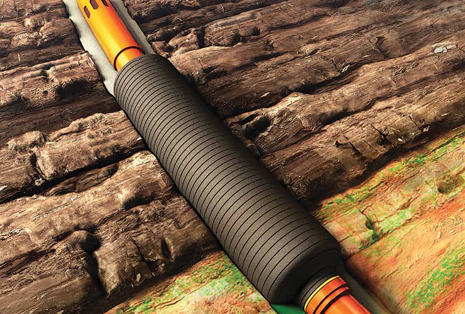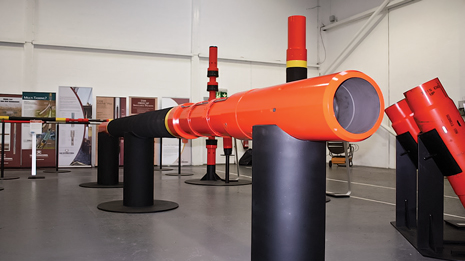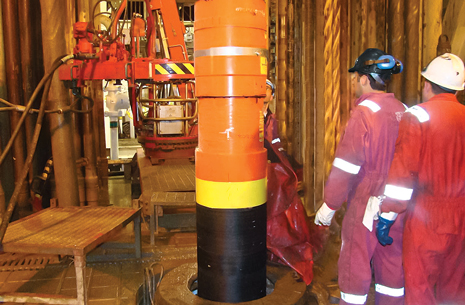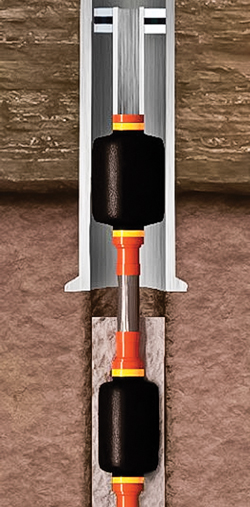JUSTIN BOWERSOCK and C. O. “DOC” STOKLEY (retired), TAM International
 |
| Stage cementing operations performed with inflatable packers and port collars provide a reliable means of enhancing well integrity. |
|
As drilling operations continue to move into more extreme environments, achieving viable annular isolation becomes increasingly critical, and significantly more difficult. Greater depths, longer laterals, hotter temperatures, tighter pore pressure-frac gradient windows, and countless other well-specific challenges require operators to utilize advanced slurry designs and pumping programs to increase the probability of achieving a successful cement job.
Though cementing technology has drastically evolved since its inception in the early 1900s, the primary functionality remains the same. Mitigating pipe corrosion, improving borehole stability and other structural enhancements are clearly of vital importance. However, preventing uncontrolled gas or fluid migration between zones, or to the surface, remains the most critical objective, as personnel safety and the environment are often at stake. Regrettably, despite recent advancements in cementing technology, a well-documented array of fundamental shortcomings precludes cement, alone, as a viable annular barrier in many environments.
As described in the May 2013 World Oil column by Jim Redden, entitled “Drilling Advances—Study Pins Down Cementing Gaps,” a recent U.S. Department of Energy (DOE)/National Energy Technology Laboratory (NETL) study identified numerous technological gaps in our current cementing processes, understanding of short- and long-term failure modes, and ability to accurately detect inadequate cement integrity. Not surprisingly, many of the findings detailed in the report are documented and supported by past industry studies.
One such initiative, conducted in the late 1970s by EPRCo (ExxonMobil Upstream Research), included three discrete research projects focused on cementing processes, chemistry and curing mechanisms. Each study yielded a great deal of information that has since been disseminated in a variety of industry presentations, publications and reports. However, one, in particular, laid the foundation for our current understanding of primary gas migration during cement hydration, and ultimately to the use of mechanical barriers to prevent it.
In the EPRCo project, a series of wells was completed with pressure/temperature sensors mounted to the outside of the casing, and hard-wired to the surface. This allowed real-time monitoring of pressure and temperature in seven unique zones of interest during mud conditioning, spacer and cement displacement, and the curing of the cement. Data revealed that, as the cement developed static gel strength, it gradually became self-supportive in isolated areas, ultimately reducing the hydrostatic head below the isolation in the annulus, until the well was in an underbalanced state. At this point, formation fluids entered the wellbore, contaminating the slurry and creating channels evidenced in post-job logs and production tests.
Following up this SPE-published data, TAM International initiated a study to evaluate the effects of actuating mechanical barriers (inflatable casing annulus packers) in the annulus, immediately following cement displacement. In the experiment, hydrostatic loads were completely supported at various intervals, and annular fluid movement was prevented at each location. In one field case, seven of 11 initial wells completed without a mechanical barrier required remedial cementing operations to achieve adequate annular isolation to control placement of the hydraulic fracturing treatments. Subsequently, 37 wells in the same field were completed with a casing annulus packer positioned 50 ft to100 ft above the reservoir, and required no remedial work before or after stimulation operations. This study, with countless others, has been leveraged to develop a portfolio of tools designed to enhance cement integrity and improve annular isolation.
Recently, TAM launched EPIC, a new initiative designed to leverage this legacy of technical and operational expertise to create application-specific, system-oriented solutions to proactively address cementing challenges in virtually every major domestic and international play, Fig. 1. By incorporating these complementary systems, operators are mitigating risks to personnel and the environment, satisfying regulatory requirements and industry standards, minimizing the quantity and complexity of intervention and remediation operations, and preventing costly production losses.
 |
| Fig. 1. This TAM International tool display in Aberdeen, complete with patented metal-to-metal HATCH Packer (foreground), is used for internal and customer training. |
|
One of the core components of this system is still the inflatable casing annulus packer. The inflatable packer typically performs one of two functions. The first, as referenced in the aforementioned study on the effects of mechanical barriers in curing cement, is to provide a means of instantaneous isolation at the conclusion of cementing operations. Once inflated, the packer prevents gas or fluid influx from migrating above the packer, contaminating slurry or creating channels that can lead to uncontrolled migration to surface. The second function is to provide a reliable platform for stage cementing operations. In this application, the packer may not need to hold much differential pressure in excess of the column of cement above it; however, it must be extremely reliable as this operation is commonly performed above an uncemented openhole completion. For example, thousands of coalbed methane (CBM)/coal seam gas (CSG) wells in eastern Australia have utilized a 7-in. inflatable casing annulus packer and hydro-mechanical stage cementing tool, installed in an 8.5-in. or 8.75-in. open hole. A viable cement job is required to isolate the 95/8-in. casing shoe, to ensure that there is no sustained casing pressure (SCP) at surface. However, the low-cost well design consists of nothing but slotted pipe in an uncemented open hole.
Another key component of this cement integrity product portfolio is a mechanically actuated stage tool (port collar), Fig. 2. Unlike a traditional hydro-mechanical stage tool, the port collar is actuated using a workstring, allowing it to maintain a full-bore ID without the need to drill out plugs, balls, seats, etc. If life of well casing integrity is required, as is the case with most production strings, a patented metal-to-metal sealing version is available. Like the inflatable casing annulus packer, the port collar can be utilized for a variety of applications. Installed in conjunction with an inflatable packer, the port collar can serve the same general purpose as the hydro-mechanical stage tool referenced above. However, the ability to displace cement above the packer and reverse out without drilling up balls, plugs and seats enables the port collar to be run above intricate ball-and-sleeve systems or other elaborate completions that can be easily fouled up by cuttings and shavings.
 |
| Fig. 2. Crews installed an ISO 14310 V5-qualified, 20-in. TAMCAP inflatable packer and port collar for stage-cementing conductor casing. |
|
A second application for the port collar is a stand-alone installation for contingency cementing operations. In these instances, there is typically a high probability that the primary cement job will not be deemed successful. Rather than repeatedly running in the hole with perforating guns to shoot holes in the casing, and squeeze cement until adequate isolation is achieved, the port collar can be opened for a contingency squeeze job. Once closed, casing integrity is regained, and subsequent operations can continue without the need for a drill out or clean up trip. This application is routinely utilized, and in some instances standardized, for operations on Alaska’s North Slope, and in the North Sea. In both areas, an array of operational challenges, coupled with stringent regulations requiring isolation at multiple intervals in the well, results in a high number of remedial cementing jobs.
A third component of the product portfolio is an integral system consisting of a metal-to-metal port collar and modified, inflatable, casing annulus packer. This tool, developed at the request of a major operator plagued by shallow gas zones offshore Indonesia, functions in the same manner as a port collar and packer screwed together. However, when the port collar is shifted closed, the metal-to-metal seals isolate the elastomeric seals in the packer’s inflation valves, leaving the operator with casing integrity. For this reason, this integral packer-port collar provides a solution for stage cementing of production casing, when regulations or recommended practices prohibit the use of elastomeric seals in this string. Placed in the open hole above the shallowest hydrocarbon bearing zone, the 95/8-in. casing annulus packer is first inflated off of a plug bump, providing the instantaneous barrier to primary gas migration. Next, a shifting tool is run in the hole to actuate the port collar. After the annulus above the inflated packer has been conditioned to remove any residual gas-cut fluid or, in many cases, annular fluids changed to water, the second stage cement job is performed, with returns brought back to surface to ensure that the previous casing shoe is effectively isolated, and sustained casing pressure at the surface is prevented. To date, there have been more than 150 installations of this tool with a near-perfect success rate.
Perhaps the most versatile of all of the cement integrity tools is the swellable packer. The packers complement cementing operations in a number of ways. The first set of applications works off of the assumption that the packers will be positioned above the top of cement (TOC). In these instances, the packer design will include rubber volume sufficient to swell and reach the outer casing, or openhole ID, to provide a full-bore mechanical barrier. Common examples of this application can be found in many long strings, where a secondary mechanical barrier is desired without introducing any potential leak paths or operational complexity to the pumping program. These packers are often placed in the previous casing shoe; however, they are also capable of differential pressure ratings in excess of 10,000 psi in the open hole, if the operator is concerned with annular pressure build-up (APB).
The second set of applications assumes that the packers will be positioned in the cement job. These packers will have an undersized OD, and often will not have sufficient rubber volume to swell to an extent to contact the outer casing or openhole ID. Rather than providing a full-bore mechanical barrier, these packers complement the cement sheath by providing a means of preventing or remediating primary or secondary gas migration. In one application, the swellable packers are utilized to swell and seal channels resulting from inadequate mud removal, when the casing is eccentric or laying on the low side of an open hole. When exposed to the correlating activation fluid, the packer will swell and seal this channel, preventing gas or fluid migration from flowing up-hole.
In applications where secondary gas migration due to sheath failure is a concern, the packers are installed at critical intervals in the well to provide micro-annulus remediation to prevent sustained casing pressure (SCP). In these applications, the packers have also proven to have the ability to mitigate the amount of diametric expansion, when internal pressure is applied to the casing, thus reducing stress-induced fracturing of the cement sheath. One major operator in the Gulf of Mexico is using a redundant system of swellable packers to ensure that liner top integrity is achieved, Fig. 3. One 20-ft swellable packer on the 7-in. production string is positioned in the cement job above the top of the reservoir to increase the probability of achieving successful isolation in the open hole. A second 20-ft packer is positioned in the 95/8-in. casing shoe to provide a redundant means of liner top isolation, in the event that the premium liner top packer develops a leak after liner top integrity tests have been performed. This proactive well design has been utilized in other critical wells around the world with virtually no failures.
 |
| Fig. 3. FREECAP swellable packers are utilized to enhance liner top integrity in deepwater applications. |
|
Operators have done an exemplary job of reassessing cementing operations and incorporating redundancies and contingencies into their well plans in recent years. However, as drilling technology evolves, so, too, must the tools and systems designed to ensure cement integrity for the life of the well. 
|
The author
JUSTIN BOWERSOCK joined TAM International in 2012, in the newly created position of global product champion for Cement Integrity. His responsibilities include leading international marketing and sales initiatives, and new product development activities for the Cement Integrity product portfolio. Mr. Bowersock holds a degree in industrial distribution from Texas A&M University.
C. O. “DOC” STOKLEY retired from TAM International in 2008, after serving as the company’s V.P. of R&D since 1982. After more than 40 years in the oil and gas industry, Mr. Stokley has worked with companies including Schlumberger, Exxon, Camco and Page Oil Tools, and EPRCo. He holds multiple patents with both EPRCo and TAM. Mr. Stokley received a BS degree in engineering from Tennessee Tech University. |
|






